For Enthusiasts - Trams
Prague Trams
The Prague tramway network is traditionally the backbone of the city's public transport system. Despite the development of the metro from the 1970s and the continued expansion of the bus network, trams continue to perform a central role, carrying broadly one third of passengers. With a route length of over 150 km and a fleet of around 700 trams, it is one of the world's largest tram systems. However, the total size of the operational fleet has reduced as new larger trams have replaced old ones: for example 961 trams in December 2010, less than 800 in 2017, just under 700 in 2023.
Click on photos to enlarge.
Tatra T3 Heaven
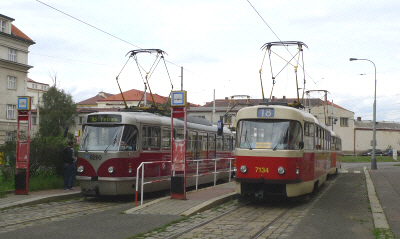
For the enthusiast, and even for the casual observer, what singles out the Prague tram system as being something special, even today, is the iconic Tatra T3 tram and its derivitives. This is a design dating to the beginning of the 1960s with a heritage linked to the innovative American PCC design which started to appear in the mid 1930s. In 1948 CKD (later CKD-Tatra from 1963) had negotiated to use elements of the PCC design (notably the control system by foot pedal) under licence, and had started manufacturing trams using these patents in 1951, initially sending royalties to the USA. Following the earlier T1 and T2 designs, this eventually led to the T3, Prague being its first customer in 1961. Over the following years the Tatra T3 was built in far greater numbers than any other tram type worldwide.
Prague has one of the biggest fleets of T3 trams, which is appropriate considering they were built in Prague, in a factory now demolished to make way for the huge Nový Smíchov shopping centre. To put this into context, however, the vast majority of T3s were actually exported to Russia and the Soviet Union, thanks to Comecon centralised purchasing during the Soviet era. Of over 14,000 built between 1962 and 1989, a huge 11,353 were delivered to 34 different Soviet fleets, Moscow alone having had 2,069 and Kiev 923. They did not feature in the large St Petersburg fleet, however, as they chose to build their own trams.
In Russia, over 1,800 T3 trams were still in service in 2016 (Metro Report 9/16), representing around 25% of Russian fleets, but numbers have certainly dwindled due to heavy usage, poor track, poor maintenance and gruelling weather. In the Czech Republic, the policy of keeping the T3s going by modernising and rebuilding has been necessary for financial reasons, and the tram undertakings (notably Prague and Ostrava) built up considerable expertise in this area, as did a handful of engineering companies keen to diversify in the post-Communist era.
A total of 1,193 T3 trams were delivered new to Prague between 1962 and 1989, and many survive today in one form or another. In mid-2011 around 70% of the Prague fleet, that's around 670 trams, still consisted of T3 types, but that is now (in late 2023) down to around 350 trams, about half of the now smaller operational fleet.
The last unmodernised examples of the standard T3 were withdrawn in 2012, and only a very small number of the later T3SUCS model from the 1980s remain in service in more or less original condition; these can be found on Nostalgic route 23. All T3 types in normal service now have modernised electronic traction equipment. Around 70 have replacement bodies built since 2001, many with low-floor areas, but even these retain the classic T3 shape. The different subtypes are examined below.
Photo: Pankrác terminus with T3R.PLF number 8260 and T3SUCS number 7134
FLEET SUMMARY: Tatra T3 types
The T3 fleet can be summarised as follows:
Tatra T3 Unmodernised
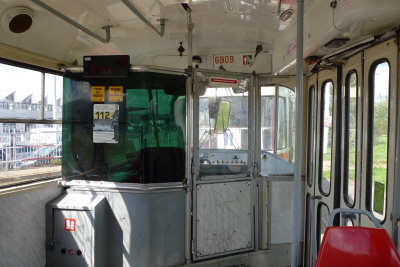
A prototype T3 was delivered in November 1960 numbered 6101 and series deliveries of the standard T3 cars commenced in 1962. Regular operation commenced in November that year from Motol and Strašnice depots. By the time the last of the standard cars entered service in 1976, 901 cars had been built, including the prototype. All T3 cars are 15.2 metres in length.
There were several sub-series with minor variations: T3s of series I and II were numbered 6102-6327 (delivered 1962-64, though 6102 dates from 1961), series III trams were numbered 6328-6505 (delivered 1964-65), series IV trams dating from 1966-68 were 6506-6715 (also 6138 and 6164 replacing accident or fire damaged trams with the same numbers). No trams were delivered in 1969. Series V trams were delivered 1970-71 numbered 6716-6810 (also replacements 6289 and 6779 in 1970/72 respectively), and the final batches (also series V) were delivered 1973-76 numbered 6811-6992 (together with replacements for 6163, 6457, 6736, 6795 and 6798).
In July 2011 only three unmodernised examples were still in service, dating from 1973-76, used as the rear car of a pair (with pantograph up) and carrying their original fleet numbers 6863, 6892 and 6921, based at Strašnice depot. Their final journey was in December 2011 when 6892 and 6921 were withdrawn from route 22.
T3 number 6149 built in 1962 is on display at the Strešovice transport museum, restored to early 1960s condition. 6102, the first production tram from 1961, was withdrawn in 1996 and following extensive restoration is also part of the heritage fleet.
Photo: the interior of unmodernised T3 tram 6909, still in service in September 2010 but withdrawn in 2011.
T3SU and T3SUCS The second coming of the T3
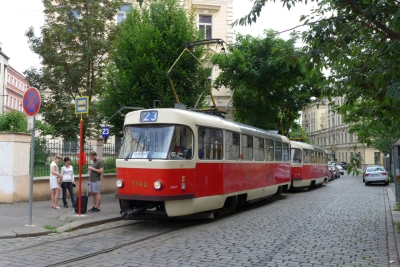
Following delivery of the last standard T3s in 1976, a gap of several years ensued, and a suitable replacement for the T3 was still not available. However, they were still being built in Prague for the Russian market, so the Prague undertaking enquired about obtaining some. These later T3s were therefore based on the Soviet version. The initial batch of 20 were designated T3SU (SU = Soviet Union) and delivered in 1982 numbered 7001-20. These were built using spare parts or uncompleted trams.
Strašnice depot were still running 12 out of the 20 in 2010, reduced to six in 2015, but these had all been withdrawn by the following year. Some were sold for further use, for example to Mariupol in Ukraine.
7001, the first of the batch, has been retained by DPP and may sometimes be found on Nostalgic route 23.
It was decided to resume deliveries, and a modified version was developed designated T3SUCS. This was basically the Soviet Union version (SU), but with slight modifications for the Czech market (hence CS). Unlike the earlier trams, the SU and SUCS models had an all-enclosed cab (also found in modernised T3s), since the driver's partition stopped short of the ceiling in the standard version. There were also some other modifications to deal with the more severe weather conditions found in Russia.
272 T3SUCS cars were built for Prague between 1983 and 1989, numbered 7021-7292. They were delivered in batches numbered 7021-70 (1983), 7071-7150 (1985), 7151-90 (1986), 7191-7252 (1987) and 7253-7292 (1989). Some of the latter (7253, 7272-92) did not enter service until 1990.
In July 2011 there were still 214 in service, reducing to 77 in September 2015, whilst at December 2017 only 18 survived, just 14 of which were in the operational fleet, running from Hloubetín depot where the older types were now concentrated. The introduction in 2017 of tourist route 23, which is advertised to use the older T3 trams, ensures that some of the T3SUCS trams remain. As at Autumn 2023, trams 7122, 7269 and 7290 were allocated to Strešovice depot for route 23, whilst 7142, 7189, 7234 and 7235 were withdrawn at Žižkov depot, and 7188 and 7205 were reported to be at the main works. 7292 was on display at the tram museum for a time.
Unmodernised T3, T3SU and T3SUCS trams (also T3M cars described below) can easily be distinguished from later modernised trams as they have a narrow route number box at the front, as opposed to a wider display on modernised vehicles showing the destination as well as the route number.
Photo above: T3SUCS 7142 and 7144 at Zvonarka terminus of route 23 in June 2017.
T3M and T3M2-DVC The first modernised T3s
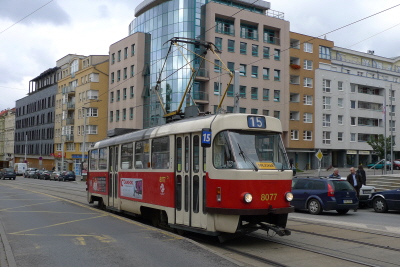
The T3M trams were the first T3s to be modernised with TV1 thyristor control equipment, replacing the mechanical system in the standard vehicle. DP Praha converted 102 trams between 1973 and 1981, even whilst new T3s were being delivered, and they were given new numbers 8005-8106. Tatra themselves were unable to supply trams with electronic equipment at the time.
In 1996-98 those with the worst corrosion were given new bodies in the standard T3 style and reclassified T3M2-DVC - there are 18 of these and they retain their 8xxx fleet numbers, namely 8009, 8015, 8051, 8053, 8063, 8067, 8068, 8072, 8074, 8076, 8077, 8079, 8080, 8082, 8083, 8087, 8088, 8089. All but 8088 are still in service (Oct. 2023), allocated to Hloubetín depot. T3M and T3M2-DVC trams can be identified by the equipment box on the roof, just ahead of the rear door.
T3M 8029 was damaged in an accident in 2001 and was subsequently rebodied by Pars Nova using parts from an Olomouc tram, reentering service in 2003 also designated T3M2-DVC. Some design features from the T3R.P (see below) were used. This non-standard tram has been used to try out various types of equipment including, in 2005, a new type of seat upholstery. It was withdrawn by July 2022.
Three T3M trams have been retained at Žižkov for the Retro fleet; these are 8013, 8042 and 8085. Car 8084 is on display at the tram museum; originally T3 6960 of 1976, it was modernised in 1981 becoming a T3M, and was withdrawn from operation in 2009.
Photo: T3M2-DVC number 8077 on route 15 in Vysocany (September 2010). In 2012 this tram became a prototype for a new electronic passenger information system. The DPP head office is immediately behind the tram.
T3R.P The standard upgrade
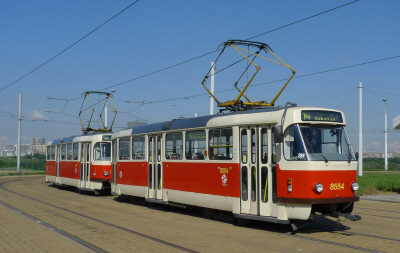
The T3R.P is Prague's standard modernised T3, originally consisting of 315 vehicles converted between 2001 and 2010. They have Progress thyristor control equipment, hence the P in the type designation. 268 of this type were in the fleet as at October 2023, 37 of which have recently been modernised with air-conditioning equipment. A few have donated traction components to T3R.PLF cars, which have new bodies (see below).
Most had as their origins standard T3 or T3SUCS cars built from 1966 onwards, although a handful of earlier cars from 1962 to 1965 were also modernised to T3R.P (many of the earlier T3s were withdrawn in the mid 1980s whereas later examples were mostly modernised). 35 cars were modernised by Pars Nova a.s. Šumperk, whilst the bulk were converted at DP Praha's main works.
They were renumbered on modernisation into the series 8211-8245 (rebuilt by Pars Nova) and 8300-8579 (rebuilt by DP Praha). They can be distinguished from unmodernised trams by the full-width destination blind at the front.
Photo: T3R.P number 8554 at Barrandov turning circle (September 2010).
T3R.PV and T3R.PLF New bodies
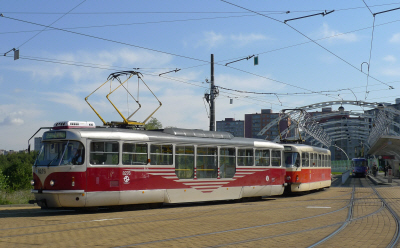
Both of these later types have new bodies due to extensive corrosion of the originals, and are therefore to a large extent brand new trams using refurbished T3 trucks. The traditional method of control by foot pedals is retained. The new bodies (designated VarCB3) were built by local company Pragoimex and are based on the distinctive T3 shape using modern methods of construction. There are 35 T3R.PV built between 2001 and 2007 and numbered 8151-8185. Most are still in service.
A later variation on the design is the T3R.PLF which has a low-floor section around the area of the central door, and three deeper windows on the off-side. The first 33 were built from 2006 to 2010 and numbered 8251-8283, being allocated to Strašnice depot. Originally they sported a distinctive maroon and silver livery with silver flashes either side of the central door, but some now carry standard livery. Certain T3R.PV trams (8159/60) and T3R.P vehicles (8564-79) were also repainted maroon and silver to run as a pair with T3R.PLF trams, but only a few remain in these colours.
Two further T3R.PLF joined the fleet in 2017/8 numbered 8284/5, carrying the standard livery, whilst 8286 to 8299 are the latest examples to be rebuilt from 2020 onwards, some of which are now in service at Strašnice (8286/7, 8293-8). Further examples are planned to carry fleet numbers 8751 upwards. The new body shells are being built by KOS Krnov in conjunction with partner company Pragoimex.
Photo: T3R.PLF number 8276 at Barrandov showing low-floor area in centre (September 2010).
Works trams
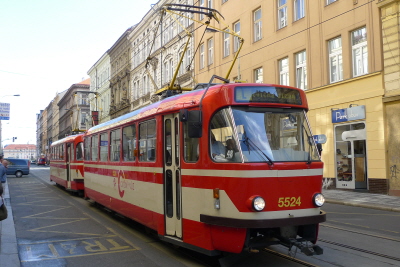
In addition to the operational fleet, around 20 former T3 trams are in the current works fleet, known as Pracovni and numbered in the 54xx or 55xx series. The majority are training cars (Cvicné). Each depot has at least one works car, whilst the training fleet is based at Pancrác depot. The central works at Hostivar has two of the works cars.
Photo: driver training tram 5524 is of type T3R.P. It joined the training fleet in 2008 and is seen here at the Zborovská tram stop in Smichov in October 2009.
Tatra K2 Articulated
Unlike Brno, Ostrava or Bratislava, Prague did not purchase any of the articulated design, the Tatra K2, which had a family resemblance to the T3. They did, however, test a prototype in the mid-1960s which was given the number 7001, then renumbered 7000 for exhibition at the Brno Fair. It entered service in Most, later passing to Brno.
In February 2023 a K2 also numbered 7000 took to the streets of Prague, marking 40 years since the last Tatra K2 trams were produced in the city. This was not the original 7000, however, but a tram built for Bratislava in 1977, being purchased by Prague in 2021 and arriving there in December 2022 following refurbishment at Brno's central works. It is allocated to Strešovice depot, which houses the museum fleet, for running on heritage routes 23 and 42, and for special events (such as the opening of the Dedina extension in October 2023). The K in the designation stands for kloubová, meaning articulated.
FLEET SUMMARY: Other types
The remainder of the fleet can be divided into the following categories:
KT8D5.RN2P Articulation 1980s style
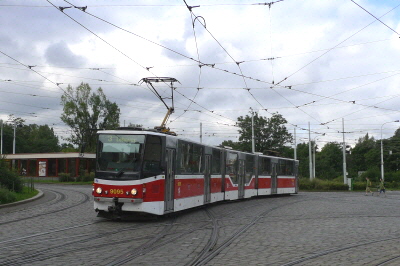
Distinctly angular in design compared to the T3, the KT8D5 was a three-section articulated tram built by CKD Tatra from 1986 to 1991, concurrently with the later T3SUCS cars. Prague took 48 of the KT8D5 between 1986 and 1990, numbered 9001-9048. Unusually for Prague, they are bidirectional trams with a cab at both ends and doors on both sides.
In a gradual modernisation programme which lasted from 2004 to 2014, 46 of the 48 trams were modernised to type KT8D5.RN2P, some at the central works and some at Pars Nova. The last unmodernised examples were taken out of service in 2013. This was a thorough upgrade with many new parts, including new TV3 traction equipment. The central section was discarded altogether and replaced by a newly built low-floor section. Fleet numbers were increased by 50 on modernisation so they are now numbered 9051-9098. The exceptions are 9056 and 9098 which were acquired from the Strausberg fleet in 2015 (numbers 23 and 21 respectively) before being modernised.
The RN2P part of the designation indicates rekonstrukce, nízkopodlažní (low floor), bi-directional (obousmerné), and TV Progress, the brand name of the electrical equipment produced by Cegelec (actually introduced while Cegelec was trading under the Alstom name). Overall length is 30.30 metres, or 31.24 metres including the couplers.
With an increasing need for bidirectional trams, fifteen KT8D5 trams have been acquired since 2016 from Miskolc in Hungary and have been or are being thoroughly refurbished and modernised at the central works, being redesignated KT8D5.RN2P. The first 12 have been allocated numbers 9099-9110, entering service from 2020 onwards. As at October 2023, 9099 to 9105 (ex Miskolc 217, 200, 205, 212, 204, 208, 211 respectively) were in service from Hloubetín depot, 9106 to 9109 (ex Miskolc 214/5, 210, 207) are in progress, whilst ex Miskolc 201, 206, 213/6 have yet to be allocated their new numbers. Since fleet numbers 9111-9170 are already in use for the 14T trams, one source suggests the remaining three will be 9171-3.
KT8D5 9048 from 1990 was not modernised and is on display at the tram museum, restored to circa 2000 condition.
Photo: KT8D5.RN2P number 9095 crossing the 'grand union' junction at Palmovka (September 2010).
Tatra T6A5 1990s successor to the T3
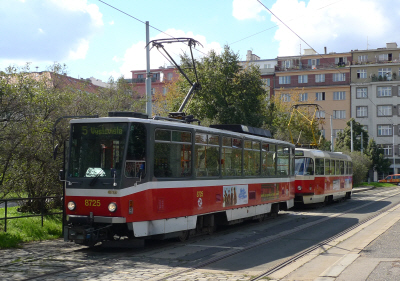
This unidirectional design was built by CKD Tatra from 1991 to 1997 with a total of 296 being built for five different Czech and Slovak fleets. Prague was the biggest customer, taking 150 of the third (and most advanced) series between 1995 and 1997, numbering them 8601-8750. They ran either as single trams or in pairs, largely depending on the route.
Since they were unsuitable for conversion to low-floor, withdrawals started in 2015, with some having been sold to other fleets, for example Sofia and Kiev, and more recently Brno. As at the end of 2017 some 85 remained in the operational fleet, with a further 17 in store, but operation finally ceased in June 2021. Two vehicles (8601 and 8750, the first and last of the batch) have been retained as Retro heritage vehicles at Žižkov depot, whilst 8702 is on display at the tram museum in original condition.
An oddity dating from 1998 was fleet number 8600 which was designated T6A5.3. Looking very much like a normal T6A5, it was in fact an experimental rebuild using some T3 parts as well as a T6A5 body. It was withdrawn from the operational fleet in 2011.
Photo: T6A5 number 8725 at the Olšanské Hrbitovy terminus of route 5 (September 2010).
Skoda 14T Trams for the new Century
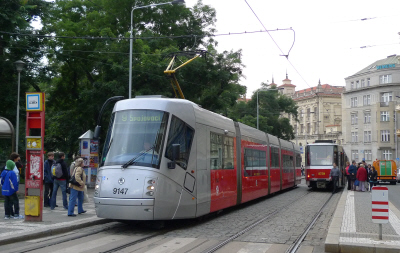
These 60 high-tech low-floor trams were built by Skoda in Plzen and delivered between 2005 and 2009, numbered 9111-9170. These were the first new trams for Prague for several years. The 14T is 30.25 metres long and has five separate articulated sections. The cabs of these unidirectional trams are partitioned off by glass screens and have their own external doors. They are often known as Porsche trams due to the involvement of that company in the design. All 60 were initially allocated to Motol depot, which then ran only 14T and T6A5 trams for several years.
Unfortunately, various design aspects of the 14T trams have proved unpopular with the public - for example the lack of a door at the front of the tram (it's only for the driver). The long overhang and uneven axle loads have also proved problematic, plus there have been many expensive gearbox failures. Despite the trams being relatively new, all were withdrawn in 2014. However, a programme to modify the trams commenced in 2016 and 21 had re-entered service by December 2017 (running from Kobylisy depot). As at October 2023, 27 modified trams (I believe officially redesignated 14T4M) were listed as operational at Kobylisy, whilst a few others were at central works. Some have been scrapped (9112, 9127, 9163/5).
Note that fleet numbers 9101-9104 were used for an unsuccessful CKD Tatra low-floor design known as RT6N1 built in 1997, following testing of a 1993 prototype. Due to regular failures they were withdrawn from passenger service in 1999 and spent most of their time out of use, despite an attempt to improve and renovate one of the trams in 2004, designated RT6N2. All four were sold in 2009. Other RT6N1 trams were delivered to Brno (4 trams), where similar problems were encountered, and Poznan (10 trams).
Photo: Skoda 14T number 9147 at Hlavní station (September 2010).
Skoda 15T ForCity A major new order
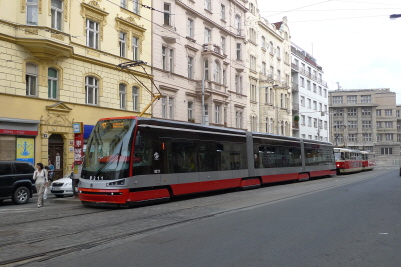
A major order for 250 new trams was placed with Skoda, these being of a new type designated 15T ForCity (the final 125 are designated 15T4 - see below). These have been specifically designed with the Prague network in mind, in an attempt to avoid the problems of the previous 14T design. They are 100% low-floor unidirectional trams with three sections and a length of 31.4 metres. Maximum speed is 60 km/h. There are 61 seats and capacity is up to 300 passengers.
A prototype numbered 9201 was delivered in 2008, whilst deliveries of production trams numbered 9202-9325 commenced in late 2010. Trials with passengers commenced in October 2010 and the first 15T trams entered officially into passenger service in February 2011. Delivery of the first batch of 125 trams was complete by 2015. Initially allocated to Pankrác depot for routes 11, 18 and 24, they are now operating on a variety of routes from Kobylisy, Pancrác and Vokovice depots.
Photo: Skoda 15T number 9211 at Strossmayerovo námestí in July 2011. These new trams made a brief appearance on route 17 in July/Aug 2011.
Skoda 15T4 ForCity Revised design
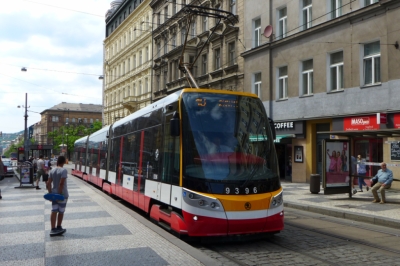
Following renegotiation of the contract with Skoda in 2014, the final 125 trams of the 250 originally ordered have some detail differences and are designated 15T4. Delivered from 2015 onwards, they are numbered 9326-9450, with the first 101 having been delivered by the end of 2017, and the remainder during 2018.
They incorporate air-conditioning and wi-fi as well as detail design differences, and can be identified by the revised livery with a yellow panel on the front, and the use of white panels instead of grey. Another feature is the different arrangement of the front lights. Motol depot has the largest allocation of 15T4 trams, whilst others are at Vokovice and Žižkov.
The new Skoda trams rapidly replaced older types, since the large capacity of the new trams meant that one new vehicle could replace two of the old T3 trams.
Photo: Skoda 15T4 number 9396 at I.P. Pavlova in June 2017.